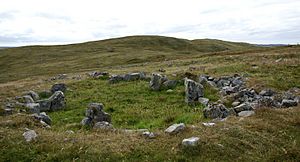Scord of Brouster facts for kids
Quick facts for kids Scord of Brouster |
|
|---|---|

One of the houses
|
|
| Location | Shetland, Scotland |
| Built | During the Neolithic Period |
| Lua error in Module:Location_map at line 420: attempt to index field 'wikibase' (a nil value). | |
The Scord of Brouster is a very old farm site in Shetland, Scotland. It was built by people during the Neolithic period, also known as the New Stone Age. This means it's about 4,200 years old! At Scord of Brouster, you can find the remains of three houses, fields with stone walls, and a cairn (a pile of stones). Around 1500 BC, the weather in Shetland got much wetter. This caused peat (a type of soil made from decaying plants) to grow around the fields. Because of this, the farmers had to leave their homes and find a new place to live.
Contents
Exploring the Ancient Farm Site
The Scord of Brouster has three houses that are shaped like ovals. These houses were built by the first farmers in Shetland.
House One: The Largest Home
The first house is the biggest. It is about 13 meters (43 feet) long and 10 meters (34 feet) wide. It has an entrance at one end and six small areas called recesses. These recesses might have been used for storage or sleeping.
House Two: A Kidney Shape
The second house is a bit smaller. It is about 11 meters (35 feet) long and 8 meters (27 feet) wide. It has a shape that looks a bit like a kidney. This house has only two recesses. One of these is about 2 meters (6.5 feet) long. Experts think this might have been a sleeping area.
House Three: The Smallest Dwelling
The third house is also about 11 meters (35 feet) long and 8 meters (27 feet) wide. It is similar in size to the second house.
Discovering Ancient Tools
Archaeologists found almost ten thousand pieces of quartz at the Scord of Brouster. Quartz is a hard, clear mineral that ancient people used to make tools. Most of these stone tools were found in the first two houses.
Tools in House One
In the first house, over 5,600 stone tools were found. Before the house was built, many tools were scattered around the area. After the house was built, fewer tools were found in the very center. Instead, they were mostly found near the walls. This suggests people worked and stored things along the edges of the room.
Tools in House Two
In the second house, over 3,700 stone tools were found. Most of these tools were found on the western side of the house and near the central fireplace. The eastern side had very few tools. This made archaeologists think that a recess in the northeast corner was likely a sleeping area, as people usually don't keep tools where they sleep.
Even though the second house had fewer tools overall, the types of tools found were very similar to those in the first house. For example, both houses had a similar percentage of scrapers, which were tools used for cleaning animal hides or preparing food.
Tools in House Three
Only a small number of tools were found in the third house. Because of this, researchers could not tell where people used to keep their tools or where they worked inside this house.

